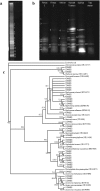Gelatinizing oil in water and its removal via bacteria inhabiting the gels
- PMID: 29070801
- PMCID: PMC5656629
- DOI: 10.1038/s41598-017-14296-x
Gelatinizing oil in water and its removal via bacteria inhabiting the gels
Abstract
When crude oil samples were shaken (200 rpm) in seawater samples from the Arabian Gulf at 30 °C, usually oil-gels were produced spontaneously leaving the water quite clear. The gelators could probably be based on cholesteryl derivatives. Microscopic examination of the established gels revealed nanofibrellar structures similar to those described by earlier workers for artificially synthesized gelators. Communities of bacteria including prosthetic and stalked members as well as oil-degrading bacteria were recorded in such gels. Chemical analysis revealed that 88.5% of the oil entrapped by gelation was biodegraded after 40 days at 30 °C. Individual bacterial species isolated from the oil-gels biodegraded in batch cultures between 17.8 and 33.3% of the oil added at time zero in 12 days at 30 °C. Gelation is a promising approach, not only for clean, physical removal of oil spilled in aquatic habitats, as so far suggested, but also in its effective microbiological biodegradation, as the current study revealed.
Conflict of interest statement
The authors declare that they have no competing interests.
Figures






Similar articles
-
Biodegradation of petroleum hydrocarbons in seawater at low temperatures (0-5 degrees C) and bacterial communities associated with degradation.Biodegradation. 2006 Feb;17(1):71-82. doi: 10.1007/s10532-005-3342-8. Biodegradation. 2006. PMID: 16453173
-
A microbiological study of the self-cleaning potential of oily Arabian Gulf coasts.Environ Sci Pollut Res Int. 2010 Feb;17(2):383-91. doi: 10.1007/s11356-009-0099-3. Epub 2009 Feb 14. Environ Sci Pollut Res Int. 2010. PMID: 19219473
-
Biotransformation of petroleum hydrocarbons and microbial communities in seawater with oil dispersions and copepod feces.Mar Pollut Bull. 2015 Dec 30;101(2):686-93. doi: 10.1016/j.marpolbul.2015.10.029. Epub 2015 Oct 20. Mar Pollut Bull. 2015. PMID: 26494249
-
Marine Oil-Degrading Microorganisms and Biodegradation Process of Petroleum Hydrocarbon in Marine Environments: A Review.Curr Microbiol. 2015 Aug;71(2):220-8. doi: 10.1007/s00284-015-0825-7. Epub 2015 Apr 28. Curr Microbiol. 2015. PMID: 25917503 Review.
-
Biodegradation of marine oil spills in the Arctic with a Greenland perspective.Sci Total Environ. 2018 Jun 1;626:1243-1258. doi: 10.1016/j.scitotenv.2018.01.173. Epub 2018 Feb 19. Sci Total Environ. 2018. PMID: 29898532 Review.
Cited by
-
Microbiomes of bloom-forming Phaeocystis algae are stable and consistently recruited, with both symbiotic and opportunistic modes.ISME J. 2022 Sep;16(9):2255-2264. doi: 10.1038/s41396-022-01263-2. Epub 2022 Jun 28. ISME J. 2022. PMID: 35764675 Free PMC article.
-
Culture-independent analysis of hydrocarbonoclastic bacterial communities in environmental samples during oil-bioremediation.Microbiologyopen. 2019 Feb;8(2):e00630. doi: 10.1002/mbo3.630. Epub 2018 Apr 15. Microbiologyopen. 2019. PMID: 29656601 Free PMC article.
References
-
- Suzuki M, et al. New low-molecular weight gelators based on l-valine and l-isoleucine with various terminal groups. Tetrahedron Lett. 2005;46:2741–2745. doi: 10.1016/j.tetlet.2005.02.144. - DOI
-
- Derossi, D., Kajiwara, Y. & Osada, Y. Polymer Gels: Fundamentals and Biomedical Applications, Plenum, New York, and references therein., 1991).
-
- Abdallah DJ, Weiss RGJ. The Quest for the Simplest Possible Organogelators and Some Properties of their Organogels. J. Braz. Chem. Soc. 2000;3:209–218. doi: 10.1590/S0103-50532000000300002. - DOI
Publication types
MeSH terms
Substances
LinkOut - more resources
Full Text Sources
Other Literature Sources
Molecular Biology Databases

